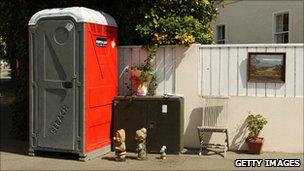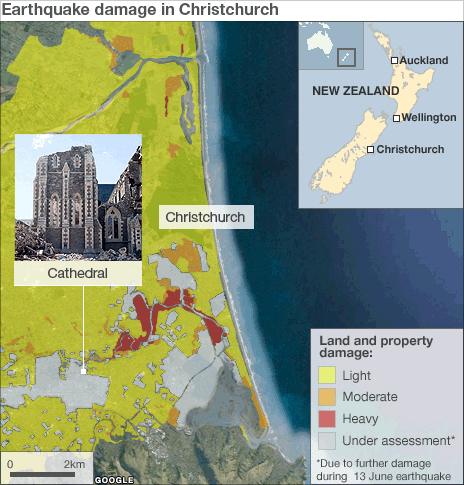Christchurch quake: Goodbye portable toilet
- Published

A wall of shipping containers lines the road to protect against falling rocks
Five months after a quake that scored a direct hit under Christchurch, it's goodbye to portable toilets but hello to rows of shipping containers lining the streets. Why?

Sumner's portable loos are, finally, no longer needed
It's almost five months on from the 22 February earthquake, and the portable toilets are soon to be removed from the streets of Sumner.
No more running along the street in desperation to these plastic cubicles. We can now flush our toilets as the sewage system for our area has been repaired and reconnected to the treatment works.
A step forward.
The roads are gradually getting asphalt patches to fill in potholes and crevices.
A step forward.
In Sumner, more geologists have been assigned to what has been classified as the White Zone, meaning the land needs more assessment for its suitability to be built on and a report will come fairly soon.
A step forward.
This started with a 7.1 quake last September, another of 6.3 in February and an overwhelming number of aftershocks.
Prime Minister John Key has said this is a disaster on an unprecedented level - the impact is equivalent to that of 10 Katrinas. The insurance cost to our country is 10% of our GDP. In Japan, with its earthquake and devastating tsunami, it's 1% of their GDP.
The central city is still in lock-down - too dangerous as the demolition continues. And some 5,000 people have had to leave their homes as the authorities have deemed their land unsuitable to rebuild on.
Box clever
What helps us cope is focusing on small achievements. Sumner is a place of visionary and enterprising people. And one person who has great vision is Dinesh Patel, a local graphic designer. He wants to create a huge work of art that will change our battered landscape.
At the moment Sumner is a village of hundreds of shipping containers. These have been craned in to make walls two high to protect roads and buildings from rocks dislodged by the aftershocks.
These metal boxes are ugly and imposing. They draw our attention to fallen rocks, unstable cliffs and homes that have fallen from a great height to road level.

A mock-up of how decorated containers might look
Dinesh wants to transform these rutted, rusting boxes into a photographic streetscape.
Photos of early Maori history, our wildlife and incredible scenery, our beloved All Blacks, and our children will be transferred on to sheets of vinyl that will totally cover the hundreds of metres of container surface to give us a timeline of our history.
Colour, vibrancy, history and the future will all be captured, with reproductions of local scenes painted by artists such as Rita Angus, Douglas Liburn, Colin McCahon and Bill Hammonds.
Although the earth still judders under us and our houses creak and sway, we can see a bright future thanks to this, and other projects to rebuild and recreate our city.
